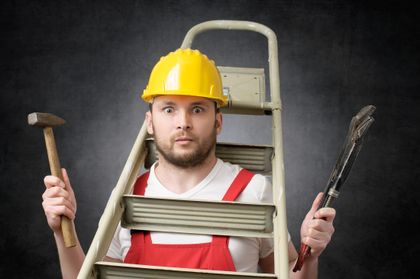How To Create Construction Safety Training For Employees
Corey Bleich
🍿 4 min. read
Construction jobsites are one of the most dangerous places to work. With so much activity swirling in and around building zones, construction safety training for employees is critical to keep everyone safe. Here's what you need to know to build your program.
Why is construction safety training important?
The construction industry sees an average of 150,000 workers in accidents each year. In 2019, almost 1,100 of those accidents were fatal. This makes the construction industry one of the most dangerous industries to work in.

The human cost is high, and so is the financial cost. Annual costs for both fatal and non-fatal accidents cost companies an estimated $14 billion.
Construction safety training protects workers and covers a variety of topics for personal safety and safe movement around a jobsite.
What construction safety training topics do I need to cover?
The U.S. Occupational Safety and Health Administration (OSHA) recommends that all construction workers undergo, at a minimum, a ten-hour safety training course. They define construction workers as those who “work for construction, alteration, and/or repair, including painting and decorating."
Through OSHA’s outreach training program, all construction workers can receive a ten-hour training, with supervisors or managers working through an additional 20 hours. These courses focus mostly on what OSHA has identified as “the Focus Four” (those hazards most likely to cause injury on a jobsite), including:
- Fall hazards
- Caught in/between hazards
- Struck-by hazards
- Electrocution hazards
Other specific construction safety training can be tailored to your industry and may include:
Although OSHA’s specific training is not required, OSHA does require some level of training in each industry. It’s best to consult OSHA’s construction safety training requirements directly.
Additionally, check with local and state governments to make sure you are developing a construction safety plan that meets your local standards.
It’s also important to note that everyone in every industry will need some basic safety training in the workplace. The goal is to give workers the support they need to safely perform their job. Some industries require minimal safety training, while others need in-depth training at a variety of levels.
How to create your construction safety training plan
Creating a construction safety training plan is important from day one and should follow six specific steps.
1. Analyze your training needs
Start by analyzing your training needs, including what training is necessary and for whom. If your company already has fairly robust construction safety training but wants to figure out how to deliver it more effectively online, your needs will be much different than a new company just starting out.
2. Identify resource requirements
What time, space, and materials do you need to design and implement your construction safety training? Identify what you need (and what you already have) to properly carry out your training.
And remember: resources go beyond training materials. You may already have workers moving in from other companies who have complete construction safety training under their belts. Consider the human resources in your company. Capitalize on the expertise they can share.
3. Consider how you’ll deliver training
Does your company want to train employees on the job, on their own time, or in a specific location? Each of these strategies have a potential to keep the work moving, safely, while employees receive training.
Incorporate safety inspections checklists at each area of the jobsite, too. This type of performance support in the flow of work means your projects move forward safely without interruptions and delays.
And don’t forget to include your contract and freelance workers in your construction safety training. Even if they are only on the jobsite briefly, they’ll need some basics of safety as well.
4. Create your construction safety training
This stage is production heavy and requires specific skills. You’ll use your knowledge of adult learning theory to create a training that is engaging, relevant, and interesting for workers at all levels.
5. Assess
Assessing the success of your training includes not only measuring on the job safety trends but also how many of your employees are actually completing the training (and applying it to their work). If completion numbers are low, simply mandating the training (or penalizing employees who don’t complete it) is not a supportive solution.
Consider:
- Adding training to onboarding
- Changing the delivery to provide more motivation
- Tweaking topics to be more job-specific
It can be hard to get it right on the first try, so the assessment stage is crucial.
6. Follow up with appropriate annual trainings
Construction safety training is definitely not a “one and done” topic. Regardless of whether you design your own course or take advantage of courses online, make sure to incorporate annual refresher courses. This helps employees keep their safety top of mind and can go a long way in preventing accidents that lead to injury or death.
We can help
Developing a construction safety training program is complicated. It’s bound by local, state, and federal laws but also tasked with keeping employees safe on the job.
EdgePoint Learning can help with co-development services or custom online training that is tailored to your industry. We can also help you roll out in-the-flow-of-work performance support or microlearning tools that make construction safety training a part of each workday.
When you’re ready to build something together, get in touch.
